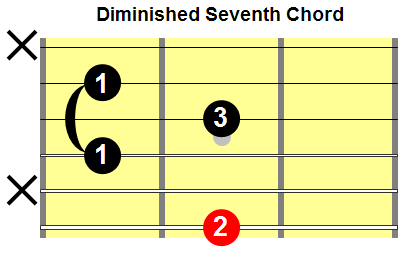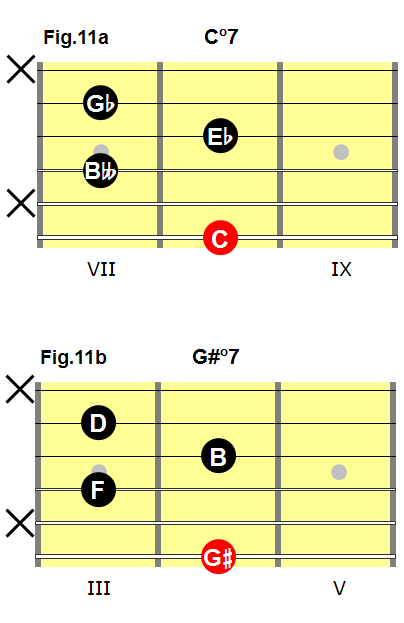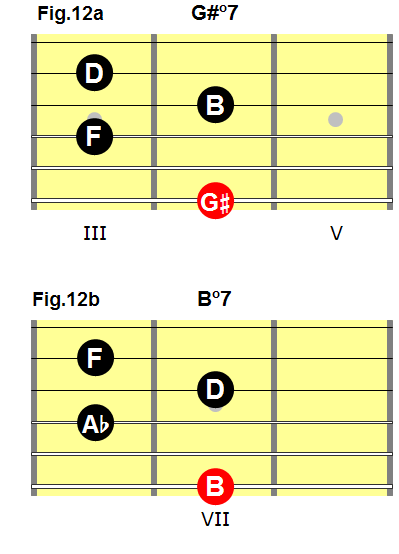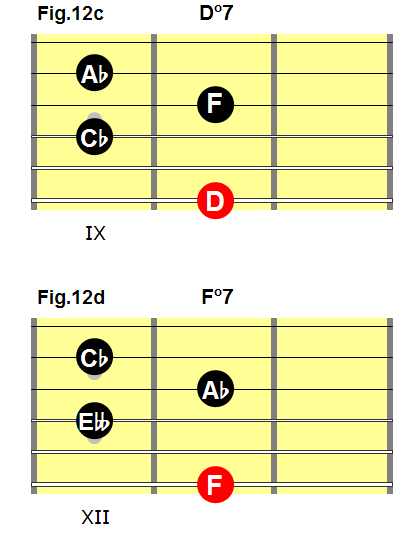The diminished seventh chord is the vii°7 chord in a harmonized harmonic minor scale.
This post will cover the diminished chord’s:
- Formula.
- Structure.
- Characteristics.
- Harmonic Functions.
It will also provide a common fingering for a diminished seventh chord, along with instruction on how to play it on a guitar with any root note.
Chord Formula
The chord formula for a diminished seventh chord is: 1, b3, b5, bb7.
A diminished seventh chord contains the first, flatted third, flatted fifth and double flatted seventh degrees of the major scale with the same root note.
For example, a C°7 chord contains the notes C, Eb, Gb and Bbb — the first, flatted third, flatted fifth and double flatted seventh notes in a C major scale (fig.1a).
Interval Structure
A diminished seventh chord contains six intervals:
- The distance between the first and flatted third scale degrees.
- The distance between the flatted third and flatted fifth scale degrees.
- The distance between the flatted fifth and double flatted seventh scale degrees.
- The distance between the first and flatted fifth scale degrees.
- The distance between the first and double flatted seventh scale degrees.
- The distance between the flatted third and double flatted seventh scale degrees.
In a C°7 chord:
- The distance between the C and the Eb is a minor third (fig.1b).
- The distance between the Eb and the Gb is a minor third (fig.1c).
- The distance between the Gb and the Bbb is a minor third (fig.1d).
- The distance between the C and the Gb is a diminished fifth (fig.1e).
- The distance between the C and the Bbb is a diminished seventh (fig.1f).
- The distance between the Eb and the Bbb is a diminished fifth (fig.1g).
Fig.1

Chord Characteristics
A diminished seventh chord is extremely dissonant, with an unsettled quality about it.
As with all dissonant chords, the diminished seventh chord needs to move to a more stable, consonant chord to resolve the tension.
Relationship to a Dominant Seventh Chord
The diminished seventh chord is closely related to another dissonant chord, the dominant seventh chord.
The diminished vii°7 chord in any given minor key shares three of the same notes as the dominant V7 chord in the same key.
For example, in a harmonized A harmonic minor scale, the G#°7 and the E7 chords both contain the notes G#, B and D (fig.2).
Fig.2

Harmonic Function
With three notes in common, both the V7 and the vii°7 chords in any given minor key are heard as wanting to resolve to the tonic i chord in that same key because the notes in the V7 and the vii°7 chords both pull strongly to the notes in the i chord.
For example, the chords E7 and G#°7 are both heard as wanting to move to an Am chord. Both chord movements — E7 to Am and G#°7 to Am — provide the anticipated resolution.
Chord Substitution
So a diminished seventh chord is commonly substituted for a dominant seventh chord in minor key progressions.
For example, the chord progression in fig.3 is in the key of A minor and contains a functioning E7 chord, one that resolves to the tonic Am chord, a perfect fifth below it.
Fig.3

The progression in fig.4 is identical to the one in fig.3 but substitutes a G#°7 chord for the E7 chord.
Fig.4

Enharmonic Equivalent Chords
Because the notes in a diminished seventh chord are all spaced a minor third (three frets) apart (fig.1, above), there is no tonal center for a diminished seventh chord.
In fact, any of the notes in the chord can be labeled — or function as — the root note. So each diminished seventh chord has four different possible names or spellings, all enharmonic equivalents of one another.
For example, the chords G#°7, B°7, D°7 and F°7 all contain the same four notes. But some of the notes are spelled differently, depending on which note we designate as the root note (fig.5).
Fig.5

G#°7 Chord
The notes in a G#°7 are spelled according to a G# major scale (the enharmonic equivalent of an Ab major scale).
A G#°7 chord contains the notes G#, B, D and F — the first, flatted third, flatted fifth and double flatted seventh notes in a G# major scale (fig.6).
Fig.6

B°7 Chord
A B°7 chord contains the same four notes, but the notes are spelled according to a B major scale (fig.7).
A B°7 chord contains the notes B, D, F and Ab — the first, flatted third, flatted fifth and double flatted seventh notes in a B major scale.
Fig.7

D°7 Chord
A D°7 chord contains the same four notes, but the notes are spelled according to a D major scale (fig.8).
A D°7 contains the notes D, F, Ab and Cb — the first, flatted third, flatted fifth and double flatted seventh notes in a D major scale.
Fig.8

F°7 Chord
An F°7 chord contains the same four notes, but the notes are spelled according to an F major scale (fig.9).
An F°7 chord contains the notes F, Ab, Cb and Ebb — the first, flatted third, flatted fifth and double flatted seventh notes in an F major scale.
Fig.9

Diminished Seventh Chords on a Guitar
Fig.10 shows a common fingering for a diminished seventh chord.
Fig.10

This fingering will allow you to play a diminished seventh chord with any root note:
- To play a C°7 chord, place your second finger on the C on the sixth string, eighth fret (fig.11a).
- To play a G#°7 chord, place your second finger on the G# on the sixth string, fourth fret (fig.11b).
Fig.11

Enharmonic Equivalent Chords on a Guitar
Any diminished seventh chord fingering can be moved up or down the fretboard every three frets (a minor third) to play the same diminished seventh chord — the same four notes —with a different voicing and an enharmonic spelling.
For example:
- A G#°7 chord played with the root note on the sixth string, fourth fret (fig.12a) can be moved up three frets to play the same chord — now labeled a B°7 chord — with the root note on the seventh fret (12b).
- The B°7 chord can be moved up three frets to play the same chord — now labeled a D°7 chord — with the root note on the 10th fret (fig.12c).
- The D°7 chord can be moved up three frets to play the same chord — now labeled an F°7 chord — with the root note on the 13th fret (fig.12d).
Fig.12


Related Posts
Related posts include:
